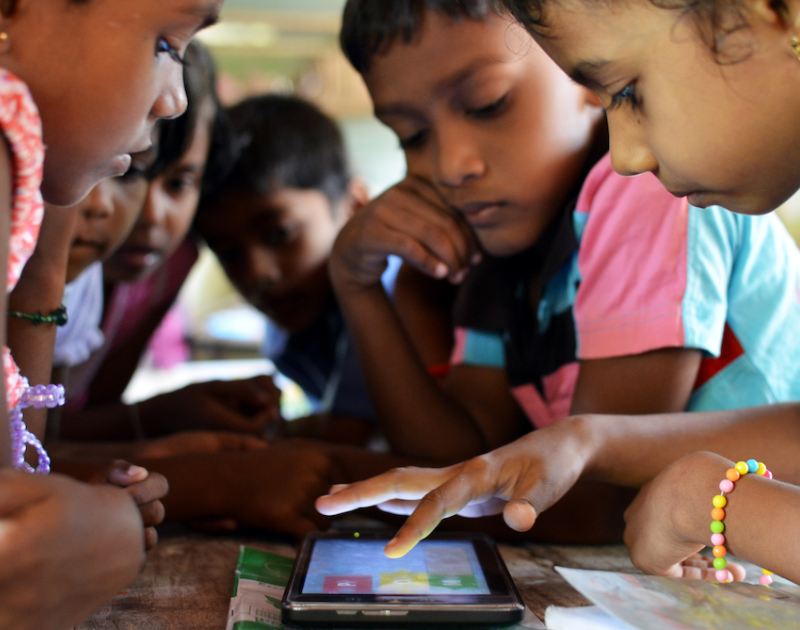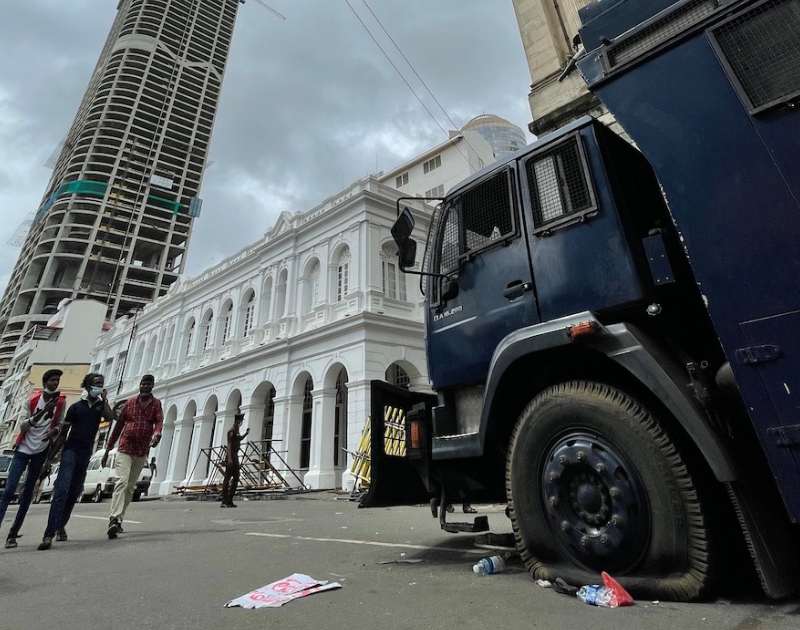
- Home
- Knowledge Insights
- SIGNALS OF CHANGE: Three Emerging Post-Covid Trends for Sri Lanka’s Apparel Sector
This article is part of the Forum’s ‘SIGNALS OF CHANGE’ series. The series provides foresight on trends, technologies and issues shaping the future, by discussing signals of change and their implications.
Sri Lanka’s apparel industry – a significant export revenue earner and employer – was substantially hit by the pandemic. Aside from the short-term supply and demand shocks, the pandemic accelerated trends that were in motion prior to the crisis, and these provide signals of change and point to the direction in which the Sri Lankan apparel industry needs to head in. As acknowledged by OECD (2020), successful risk management strategies at the firm level include an “emphasis on risk awareness, greater transparency in the value chain, and promoting agility”(p.2)[i]. As noted by a Sri Lankan stock exchange-listed fabric maker, “Primary driver of retail growth remains digital channels while heightened focus on environmental sustainability and social justice has led to increased demand for greater accountability and transparency”[ii]. This article explores three of these key trends and implications for Sri Lanka.
At the supply chain level, resilience is reinforced by various mediums, including reshoring, diversification, regionalisation, and replication and the global apparel value chain is likely to experience many of these at different levels during the crisis and post-crisis periods[iii]. Zhan et al. (2020) notes that, diversification of sources is expected to be the most widely used in actual practice, followed by reshoring, regionalisation, and replication. These was further confirmed by Deloitte (2020), in a study on the implications of global supply chain shifts for Sri Lanka[iv].
The Covid-19 induced global shutdown and supply disruptions caused have made many companies recognize their over-reliance on supplies from China[v]. These companies are now actively seeking new suppliers and manufacturing locations outside of China with the rising cost of production in China and to diversify their supply-chains and risk. As noted by an industry leader in a message to shareholders, “because of COVID-19, companies are apprehensive about relying on a single destination for its supply chain and are moving away from China and looking at the South Asian region”, adding that “supply chain strategising to maintain the total supply chain within a country and mitigating its reliance on a single destination may become a reality in the future” (p.7)[vi]. Industry officials also believe that the US-China trade tensions could have positive ramifications for countries such as Sri Lanka and others within the South Asian region.
Clearly, there is a window of opportunity for countries like Sri Lanka to benefit from supply chain shifts that are currently underway. Sri Lanka’s focus should be on proactively promoting Foreign Direct Investment (FDI) to attract investors looking for new locations and support existing firms here to find joint venture partners. The country’s geographic location, competitive and efficient port, preferential market access to the EU and US, and bilateral FTAs with South Asian countries, and firms’ focus on ethical and sustainable business practices, can feature in these promotional efforts. The Government and industry’s joint efforts to establish a ‘green textile park’ in the Eastern town of Eravur will also strengthen the country’s position in the sector, as it helps secure more of the supply chain domestically and can be seen as a vital sourcing-risk mitigator.
Meanwhile, retaining existing, as well as enhancing, preferential market access (EU GSP Plus, US GSP, etc.) will be essential to making the country an attractive FDI location. On retaining current advantages, recent developments with the EU GSP Plus have cast worries. In June 2021, the European Parliament passed a resolution that, among other things, called on the EU Commission. to investigate and subsequently consider temporary withdrawal of GSP Plus concessions granted to Sri Lanka, citing deteriorating human rights conditions and the Government’s non-adherence to certain legal reforms that the country had committed to (which are conditionalities under the GSP Plus scheme). The apex industry body JAAF has urged the Government. to ensure the continuation of GSP Plus as it is “necessary when the industry faces significant challenges in the post-pandemic world”.
With the uncertainties surrounding the pandemic, new variants continuing to emerge, sudden lockdowns and travel restrictions, and the overall Covid-19 pandemic likely to have long-tail effects, retailers and consumers purchasing behaviour is likely to have changed permanently. Evidently, brands and stores (whether physical or online) would prefer having smaller inventories and not hold stocks. As such, they would prefer to work with manufacturers that can be agile and nimble in adjusting to market demands. A McKinsey (2021)[vii] survey revealed that a vast majority of fashion industry executives are deploying several strategies to avoid overstock – 61 per cent plan on reducing the number of SKUs[viii], 60 per cent reported they would improve analytics for consumer insights, 55 per cent said they plan to implement a more agile supply chain, and 43 per cent would reduce product development lead times.
Some larger Sri Lankan manufacturers are well positioned for this, given their focus on innovation, logistics and design in recent years, while some others (more traditional players and SMEs that rely on the more traditional seasonality and orderbook model) would find it difficult to adjust. Leading apparel exporter MAS Holdings has two unique initiatives to latch on to this trend and ensure resilience in the face of the fashion industry pressures. The first is ‘Runway Kit’ – the digital arm of MAS’ manufacturing – set up to support small and medium-scale apparel brands in sample making and manufacturing swimwear and activewear under low minimum order quantities (MOQs)[ix]. The second is ‘MAS Click’ is a ‘concept-to-delivery’ business model that helps brands rapidly adapt to evolving consumer demand, by testing consumer preferences with low MOQs and replenish bestsellers multiple times, in-season[x]. The company uses advanced analytics across sales data and consumer sentiment to gain insight on style performance, and helps the brands derive greater profitability by minimizing the risk of markdowns, slow moving stock and returns.
While firms focus on enhancing their internal capabilities in design, digital, and process efficiency to capitalize on these trends, as an economy Sri Lanka should focus on accelerating reforms to trade facilitation (i.e., border efficiency) and removing trade-related obstacles.
Many of Sri Lanka’s larger players had invested in digitalization of systems processes prior to the pandemic, and this helped them remain resilient – whether it was relating to work from home following the first lockdown, to contact tracing and risk management in plants, to delivering better customer solutions. Industry players have also used technology to help product creation teams to anticipate, validate and research to understand pricing, customer preferences, sales trends – all of which were upended by the pandemic. Digitalization had helped incorporate a feedback loop into product design and reduce lead times and speed to market. Technology had played a role in virtual prototyping for firms like MAS Holdings, who had previous relied exclusively on in-person visits. As noted by their Chief Digital Officer, “We would usually pack our bags and visit our customers and present it on a catwalk. Now product presentations are done digitally”.
Evidently, however, there is some ongoing discussion in the apparel industry about finding ‘the right balance’ between striving for agility and building in redundancy. The latter comes from the disruptions to the supply chain observed during the pandemic and difficulties in sourcing the required inputs (the first of the three shocks, outlined earlier). At the time of writing, the industry is faced with another challenge – the severe shortage of shipping capacity and associated delays and heightened freight costs. Apparel industry leaders interviewed noted that traditional ways of building redundancy is not feasible, and redundancy is being redefined. Firstly, the type of redundancy is changing, and secondly the way in which redundancy is being achieved is changing and a form of ‘flexibile redundancy’ appears to be emerging. Redundancy by way of holding inventory purely in a manufacturers own location, in-house, is being pursued much less than redundancy across the supply chain. Manufacturers are entering risk-sharing arrangements with customers, for inventory buffers. Moreover, redundancy by way of holding inventory is being focused not on the finished product, which was the traditional approach, but more at the raw material stage. Enabling ‘flexible redundancy’, and consequently achieving resilience in the supply chain, is being pursued by manufacturers through at least three different approaches – 1) outright owning more of the raw material supply chain (upstream investments in fabric mills, for instance); 2) deep strategic relationships with suppliers with who dynamic adjustments to inventory can be made at little cost and time commitment; and 3) even if it is not 1) or 2), at least having the suppliers onshore rather than offshore (the example the proposed Eravur Fabric Park discussed in the previous section).
One industry leader outlined that a key focus for enabling flexible redundancy across the supply chain – in a bit to build resilience – is for Sri Lankan apparel firms to have presence in countries outside Sri Lanka. Top customers in the US, UK and Europe have increasingly prevailed on their Sri Lankan manufacturing partners to distribute manufacturing (i.e., location diversification) and build redundancy through production facilities in other countries. This has added a new dimension to Sri Lankan apparel firms’ strategy of investing overseas, which was hitherto largely driven primarily considerations of cost efficiency (cheaper labour costs or preferential tariff advantages) and logistics proximity. Already, Sri Lankan manufacturers like MAS, Brandix, Hirdaramni and Hela have production facilities in Bangladesh, Indonesia, Honduras, Jordan, Vietnam, Haiti, Ethiopia, Kenya, and USA, and this has helped keep these players competitive amidst rising manufacturing costs and a tightening labour market at home, and Sri Lanka’s stalled trade integration that affords preferential market access for its exporters.
A looming twin-challenge facing the industry is escalating labour costs and the dependence on GSP Plus concessions (to the EU), which some have argued have reduced the competitiveness of the industry and increased vulnerability of the sector to global market shocks. To counter this, the apparel industry has begun to climb the value chain with innovation and improving environmental sustainability. As noted by a sector leader in a message to shareholders, “A key future strategy is innovation and development of sustainable products such as biodegradable products, bio-based materials and chemical-free performance products” (p.7)[xi]. In a recent poll of fashion industry executives, around half indicated that sustainability has moved up the list in the post-Covid environment[xii]. Sri Lankan apparel manufacturers have begun a more strategic and formalized in-house focus on innovating new products that embody sustainability principles. Leading exporter Hirdaramani Group launched in 2019 their ‘Hirdaramani Discovery Lab’ as a product innovation and technology centre to develop and implement products, processes and technical innovations to achieve higher levels of sustainability and productivity[xiii]. Another leading manufacturer, Brandix, has had a long-standing focus on sustainable manufacturing, having opened their first green apparel factory in 2008 which was the first manufacturing facility in the world to be rated Platinum under the LEED Green Building rating system and more recently being recognized for the world’s first Net Zero Carbon certified manufacturing facility in Batticaloa.
The sector will also benefit from having access to innovative fabrics that are particularly relevant in a post-Covid era. A leading Sri Lankan ‘welt knit’ producer, who supplies many of the apparel firms in the country, have developed a collection that focuses on so-called ‘defensive fabrics’ such as antiviral/antimicrobial defences, textiles with carbon compounds, as well as sustainable fabrics[xiv]. Also as noted earlier, Sri Lanka intends to establish a ‘green industrial park’ for fabric production, with state-of-the-art facilities for water treatment and affluent management. This is an important step, considering that the highest resource use occurs during wet textile processing – over 80% of the water, over 75% of energy and nearly 60% of chemicals are used in wet textile processing[xv]. Recently, the Sri Lanka office of the International Union for the Conservation of Nature (IUCN) in partnership HSBC Sri Lanka launched a ‘Road Map to a Greener Apparel Sector in Sri Lanka: A Sustainable Financing Strategy for Sri Lanka’ that recommends 12 areas for the apparel sector to focus on, which includes renewable energy, zero-discharges, science-based targets, circularity, and sustainable financing[xvi].
The rapid vaccine rollout in Sri Lanka’s key markets of US, UK and EU, and the concomitant decline in the spread of Covid, will help the industry turn a corner. Winter season orders are reportedly at strong levels. Already various data in these markets relating to economic activity, purchasing inventory, retail sales and household spending point to an overall recovery in consumer sentiment and in turn boosts demand for Sri Lankan apparel exports. Risks of new virus variants notwithstanding, the short-term future of the industry looks promising, if the domestic health conditions remain in control. The medium-term future of the industry – moving from recovery to resilience and a new wave of growth – will rely on doing new things and doing current things better. This includes attracting new investment that drives innovation (in business models and products) and plugs into new supply chains; and on focussing on meeting more stringent sustainability and other compliance requirements of buyers and preferences of consumers.
—————————————————————
This article draws from work for a larger paper to be published by Konrad-Adenauer-Stiftung (KAS), Regional Economic Programme Asia (SOPAS).
[i] OECD (2020), ‘COVID-19 and global value chains: Policy options to build more resilient production networks’, OECD Policy Responses to Coronavirus (COVID-19), 3rdJune 2020, Organization for Economic Cooperation and Development: Paris.
[ii] Hayleys Fabric PLC (2020), Annual Report 2019-20, Retrieved from
https://cdn.cse.lk/cmt/upload_report_file/403_1622543611245.pdf.
[iii] Moazzem et al. (2021)
[iv] Deloitte (2020), ‘Global Supply Strategies: Current Trends & Future Shifts’, Report produced for USAID-PARTNER Activity, Colombo.
[v] Bell, S. (2020), ‘Thoughts on Business Opportunities for Sri Lanka Post-COVID-19’, 23rd April 2020, Retrieved from LKI:
https://lki.lk/blog/thoughts-on-business-opportunities-for-sri-lanka-post-covid-19/.
[vi] Teejay Lanka PLC (2020).
[vii] McKinsey and Business of Fashion (2021), State of Fashion 2021, Retrieved from
https://www.mckinsey.com/~/media/McKinsey/Industries/Retail/Our%20Insights/State%20of%20fashion/2021/The-State-of-Fashion-2021-vF.pdf.
[viii] Stock-keeping unit
[ix] MAS Holdings, ‘Low MOQ manufacturing’, Retrieved from
https://www.masholdings.com/low-moq-manufacturing.html.
[x] MAS Holdings, ‘MAS Click’, Retrieved from https://www.masholdings.com/mas-click.html.
[xi] Teejay Lanka PLC (2020).
[xii] Participant poll: GFA (2020), ‘McKinsey Sustainability in Fashion’ Apparel, Fashion & Luxury Executive Webinar n >300
[xiii] HSBC and IUCN Sri Lanka (2021), . A Roadmap Towards a Greener Apparel Sector: A Sustainable Financing Strategy for Sri Lanka. Colombo, Sri Lanka: IUCN Sri Lanka and HSBC.
[xiv] Teejay Lanka PLC (2020).
[xv] HSBC and IUCN Sri Lanka (2021).
[xvi] ibid.
Cover image courtesy HuffingtonPost.com – https://www.huffpost.com/archive/in/entry/sri-lankas-garment-factory-workers-coronavirus-pandemic_in_5fae6868c5b6b363336975a2


